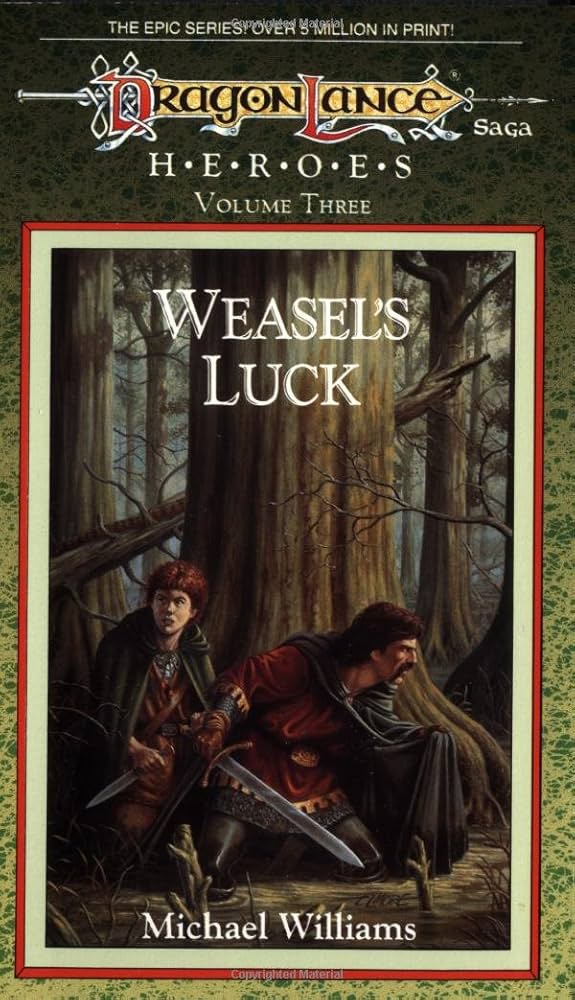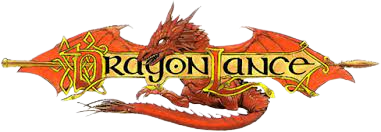Weasel’s Luck

Table of Contents
ToggleOverview
Weasel’s Luck is a prequel and character origin story, set a generation before the War of the Lance. It follows Galen “Weasel” Pathwarden, a cowardly, sarcastic noble who becomes an unwilling squire to a young Knight of Solamnia—Sir Bayard Brightblade, the noble ancestor of Sturm Brightblade.
Told in first-person memoir style, the novel is a humorous and self-deprecating romp that balances comedy with rich worldbuilding, layered character arcs, and genuine emotional depth. Despite the light tone, it asks serious questions about honor, loyalty, and how stories shape legacies.
Main Character: Galen “Weasel” Pathwarden
- A spoiled, reluctant noble from a minor Solamnic family.
- Cowardly, clever, lazy, and full of sarcastic observations.
- Becomes squire to Sir Bayard against his will and gets caught up in events far bigger than himself.
- His arc is one of self-growth, stumbling toward maturity and—eventually—courage.
Supporting Characters
- Sir Bayard Brightblade – The idealistic, gallant young knight. Everything Galen is not. His nobility and literal interpretation of honor often get him into trouble.
- The Scorpion – A mysterious, cunning enemy who repeatedly tests Bayard’s virtue and Galen’s loyalty.
- Enid Di Caela – A noblewoman with whom Bayard is enamored, but whose role in the story is more complex than she first appears.
- Pathwarden Family – Galen’s dysfunctional, self-serving noble family, who often work against him as much as with him.
Setting
- Takes place primarily in Solamnia, the homeland of the Knights of Solamnia, during a time when their reputation and authority are waning.
- The world is pre-War of the Lance, in a time of moral confusion, with the old ideals of chivalry being challenged by political decay.
Plot Summary
A Reluctant Squire
The story begins with Galen Pathwarden being forcibly made a squire to Sir Bayard, a knight so noble and upright that he seems born out of legend. Galen is disgusted by the idea of honor, bored by battle, and afraid of everything—especially getting killed.
Bayard, meanwhile, has been tasked with a noble quest—to retrieve a relic, uncover a conspiracy, and defend the honor of his knighthood. Galen gets dragged along.
An Anti-Hero’s Journey
Through taverns, tournaments, dark roads, and mystical encounters, Galen witnesses a knight’s tale in action, often making a fool of himself (and surviving by luck more than skill). He’s chased by assassins, manipulated by sorcerers, and taunted by the enigmatic villain known as The Scorpion, who seems to know everyone’s secrets.
Galen’s narration is full of:
- Wry observations
- Cynical commentary on knightly virtue
- Unreliable narration—he’s clearly not telling the whole truth
Yet, as the quest unfolds, Galen begins to change. His loyalty to Bayard grows, and when faced with real danger, he starts making real choices—ones that require actual courage.
The Climax
In the end, Galen is forced into a moment of true bravery, where no one is watching, and no tales will be told—the purest kind of heroism. He saves lives, exposes a betrayal, and ensures Bayard’s legend remains intact, even if his own role is omitted.
The novel ends with Galen older, wiser, and still cheeky—but clearly changed. His final reflections show maturity wrapped in sarcasm.
Themes
- True Heroism vs. Perception – Bayard wants to be a legend; Galen ends up acting heroically without wanting to.
- Honor and Hypocrisy – The novel examines what the Knights of Solamnia claim to represent vs. what they actually do.
- Growth Through Adversity – Galen’s journey is messy, reluctant, and far from noble—but it’s deeply human.
- Satire of Chivalry – Williams pokes fun at the tropes of knightly tales while still celebrating their core ideals.
- Storytelling and Legacy – Galen’s unreliable memoir forces readers to ask: Who really gets remembered? And who shapes the story?
Tone & Style
- First-person narration, full of wit, irony, and snark
- Light-hearted, but not shallow—there’s genuine depth underneath the humor
- Reads like a mix between Don Quixote, The Princess Bride, and Blackadder
- Unique in Dragonlance for its playful, self-aware voice and satirical tone
Reception
Weasel’s Luck is praised for:
- Being one of the funniest and most original Dragonlance books
- A refreshing take on fantasy tropes, especially for readers tired of stoic heroes
- A surprisingly heartfelt story, especially in Galen’s character development
- Its memorable voice, thanks to Williams’s poetic and playful style
Criticisms are rare but include:
- A slower pace for readers expecting big battles or high magic
- Galen’s snarky tone might be off-putting to those who prefer more traditional fantasy heroes
Final Thoughts
Weasel’s Luck is a clever, touching, and sharply written tale that celebrates and critiques chivalry, heroism, and the stories we tell about ourselves. It’s as much about becoming worthy as it is about seeing worth in unexpected places.
Recommended for:
- Fans of satirical or character-driven fantasy
- Readers who love unconventional narrators and coming-of-age arcs
- Anyone who wants to understand the roots of Sturm Brightblade’s noble lineage
“I may not have been a brave man, but I had moments. And sometimes, moments are enough.”
